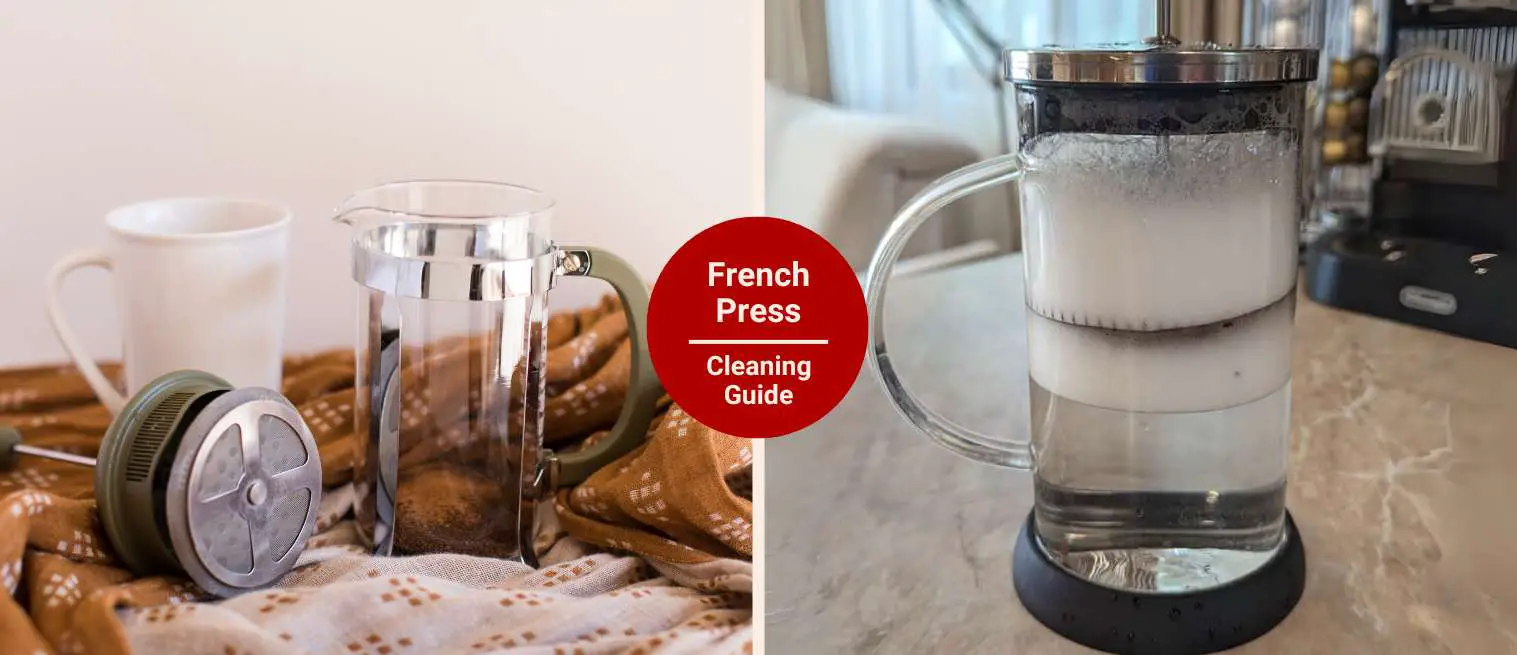How to Clean a French Press (Step-by-Step Guide)
Last updated on September 30th, 2025 at 12:15 pm
Ever brewed a cup in your French press only to wonder why it tasted bitter or smelled a little funky?
I definitely did plenty of things wrong at first. When I first bought my press (long before Coffee Voilà existed), I was living with roommates and thought it was meant as a quick coffee maker.
Brew, splash some water inside, dump the grounds, and move on with my day.
No big deal, right? Except after a while, the coffee started tasting flat, the glass looked cloudy, and the plunger got harder to push.
I didn’t realize back then that skipping proper cleaning was slowly ruining both the taste and the press itself. Now, 20 years later, I know better.
The good news? You don’t have to repeat my mistakes. With the simple steps in this guide, you’ll learn exactly how to clean a French press so your coffee stays fresh, your press lasts longer, and you never have to drink another bitter, sludge-filled cup again.
Key Takeaways
- Clean after every brew: A quick rinse with warm water and mild soap stops rancid oils and bitter flavors.
- Deep clean weekly: Take the press apart and scrub filters to prevent hidden residue and clogged mesh.
- Vinegar monthly: A simple vinegar rinse removes mineral buildup, especially if you have hard water.
- Dry completely: Never reassemble damp, as trapped moisture can lead to mold, odors, and stale-tasting coffee.
Why Cleaning Your French Press Matters?
I get it, brewing coffee is work enough. Do we really need to wrestle with cleaning the French press afterward? The short answer is yes, and here’s why:
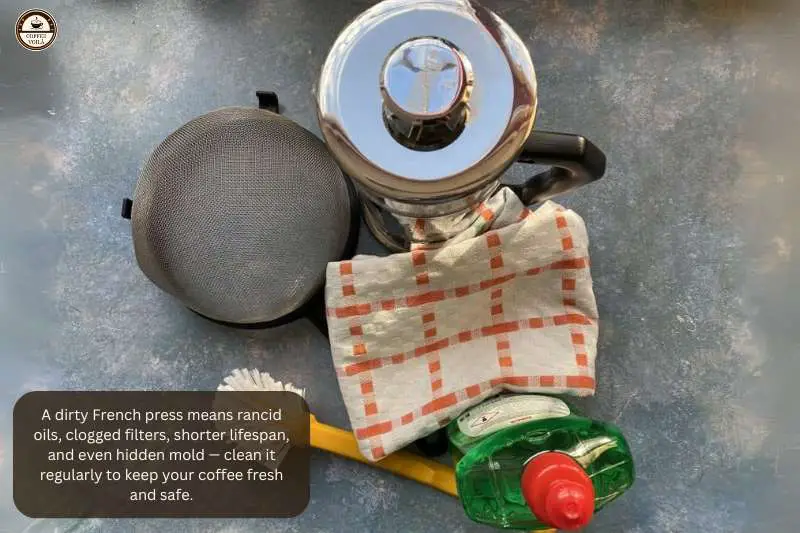
Rancid Oils Ruin the Taste
Coffee beans are naturally oily, and those oils stick to the glass, mesh, and plunger like glue. By leaving them sitting overnight, they go rancid fast.
And instead of that rich, smooth press you’re craving, you get a weird bitter edge similar to burnt nuts.
I once brewed after skipping a wash the day before, and the difference was shocking. I poured half the cup down the sink. If your French press coffee ever tastes “off” even with fresh beans, dirty oils are usually to blame.
Grounds Clog the Mesh Filter
Coffee grounds are stubborn little things. They clump at the bottom, stick to the sides, and wedge themselves right into the filter mesh. If you don’t clear them out, they build up.
Eventually, you’re plunging through sludge, not coffee. I’ve dumped the press straight over the trash before, and all it did was spray wet grounds everywhere.
I’ve even whacked my stainless steel press against the bin to loosen grounds, only to splatter the floor. I know cleaning may feel boring, but unclogging filters later is worse.
Cleaning Extends the Life of Your Press
A French press isn’t glass and steel; it’s tiny screws, mesh layers, and delicate seals. When coffee residue builds up, the filter bends, the plunger squeaks, and even the glass can get cloudy.
I learned the hard way when my first press lasted barely a year before the filter warped from buildup. Now, my last press has been going strong for years because I take it apart and scrub it.
Mold and Bacteria Hide in Surprising Places
One gross part that nobody often thinks about: a damp French press is basically a welcome mat for mold. Usually, grounds get trapped under the mesh, in the lid crevices, or even around the plunger shaft.
You might not see it, but you’ll smell it: that sour, swampy funk that no amount of fresh coffee can mask.
What You’ll Need?
The good part is you probably already have everything you need in your kitchen. So, here’s the list:
Warm Water
It sounds obvious, but warm water is your best friend here. For this, you want it hot enough to loosen oily residue. But not boiling, you don’t want to risk cracking a glass carafe.
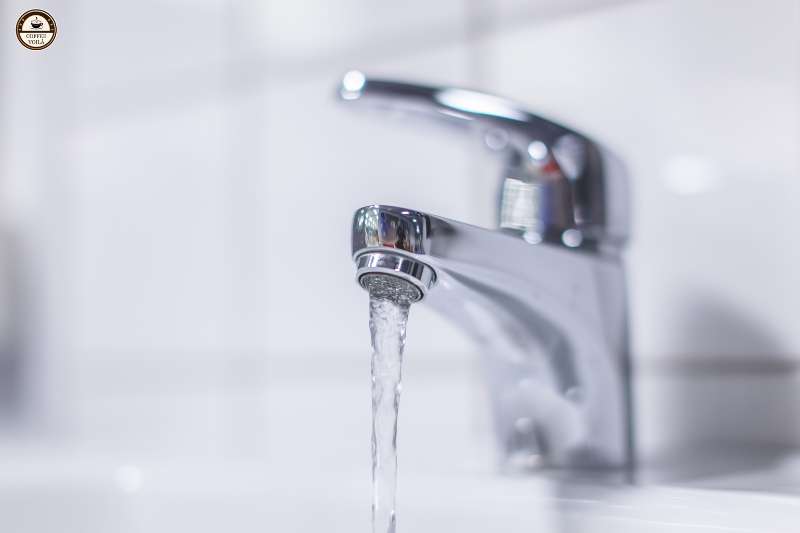
I usually give mine a swirl of warm water right after brewing. This helps keep the grounds from cementing to the bottom like concrete.
Mild Dish Soap
Don’t go for heavy-duty cleaners like bleach or oven spray. A drop or two of mild dish soap is all you need to cut through coffee oils without leaving a chemical aftertaste.
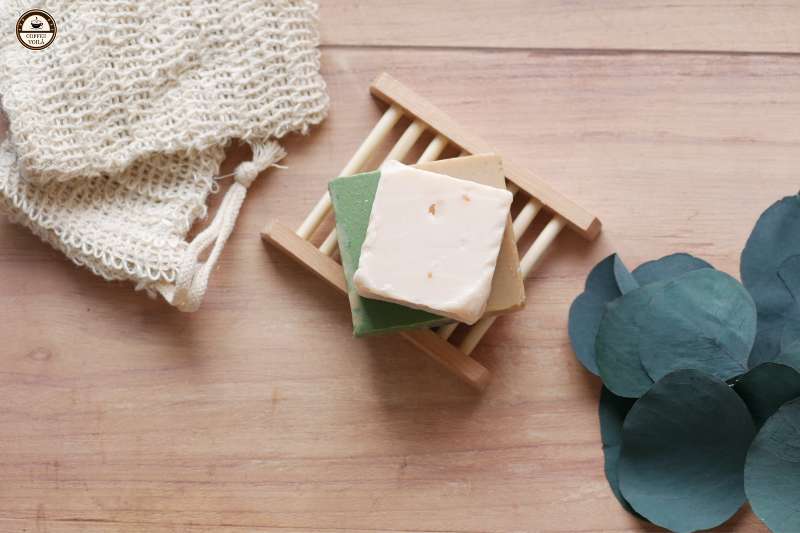
Non-Abrasive Sponge or Bottle Brush
French press glass scratches easier than you’d think, and even stainless steel can pick up scuff marks. That’s why I stick to soft sponges or a long bottle brush.
The brush is a lifesaver if you have one of those tall presses where your hand barely fits inside (example: the Cafetto or OXO bottle brush works perfectly).
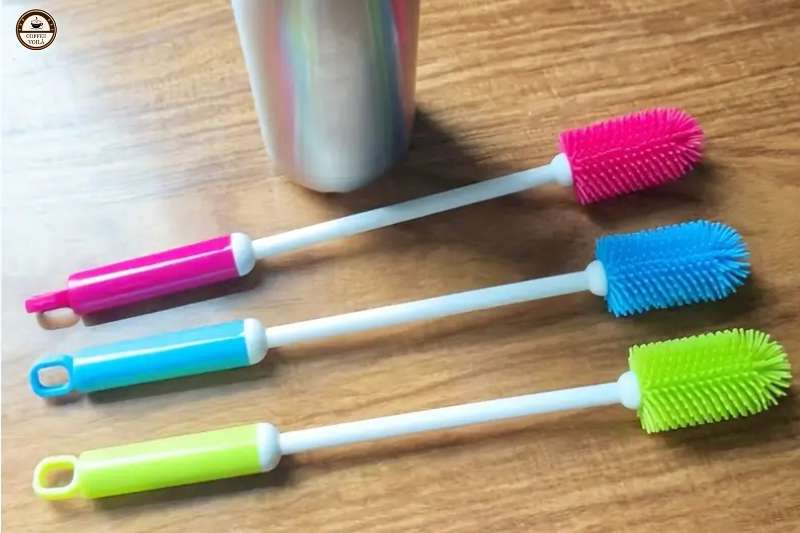
Wooden or Silicone Spatula
I learned this one the hard way: never scrape grounds out with a metal spoon. It leaves scratches, and scratches are like little traps where rancid coffee oils love to hide. A silicone or wooden spatula scoops the clumped grounds without gouging your press.
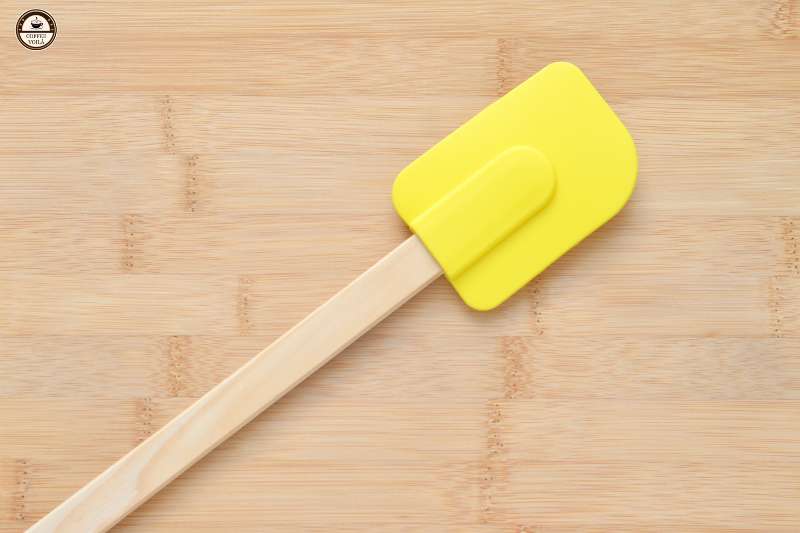
Optional: Baking Soda or Vinegar
For deep cleaning days, baking soda and vinegar are my secret weapons. With baking soda, you sprinkle a little on your sponge to lift stubborn stains and odors.
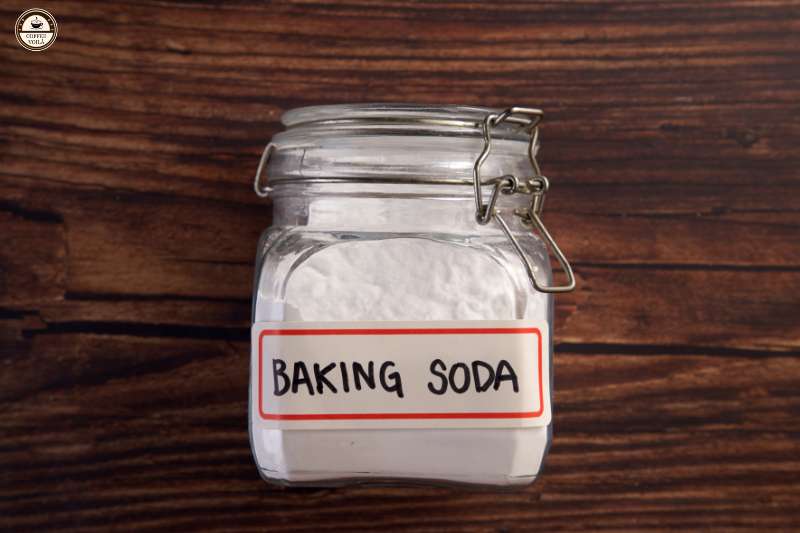
On the other hand, vinegar is great if you’ve got hard water. A quick vinegar rinse every month or so keeps mineral buildup from making your coffee taste flat.
Just be sure to rinse thoroughly afterward, unless you enjoy coffee with a salad-dressing aroma.
Clean a French Press After Each Use (Step-by-Step)
Do yourself a favor and follow this quick routine. It only takes a few minutes and keeps every cup tasting fresh.
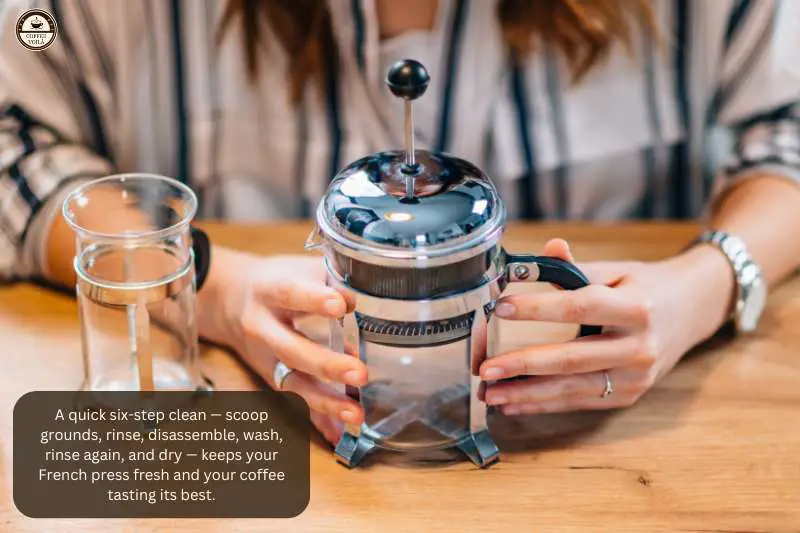
Step 1) Discard Coffee Grounds
Grounds cling to the bottom like wet sand, and if you just dump them in the sink you’ll be calling a plumber eventually.
For this reason, scoop them out with a wooden spatula, or grab a damp paper towel and wipe the clumps right into the compost bin or trash.
If you’ve got a garden, dilute them with water and pour them outside. Plants love the nutrients, and it keeps your garbage bag from turning into a soggy mess.
Step 2) Rinse with Warm Water
Before oils dry and harden, fill the carafe with warm water and give it a swirl. This loosens the fine particles that cling to the sides and prevents that sticky brown film from forming.
Some mornings I do this immediately after pouring my last cup, and by the time I come back, most of the grit has floated free.
Step 3) Disassemble the Press
Don’t just wash it assembled. Coffee grounds hide in sneaky places. For instance, under the filter mesh, in the threads of the plunger, even around the lid. So, take the plunger apart piece by piece.
Step 4) Wash with Soap and Sponge
You can add a drop of mild dish soap and scrub gently with a soft sponge or bottle brush. As mentioned, don’t go for heavy-duty cleaners. They’ll damage the steel and leave your press smelling like chemicals.
If you’ve got a tall carafe, this is where a long-handled brush is worth every penny.
Step 5: Rinse Thoroughly
If you rush this step, the next brew will carry a faint, soapy note and believe me, coffee and dish soap is a pairing nobody wants.
For this reason, run warm water through every part until it feels squeaky clean. I even give the mesh filter an extra rinse under the tap, simply to make sure no bubbles linger.
Step 6) Air Dry or Towel Dry
Now comes the easiest step, but don’t skip it. If you reassemble the press while it’s damp, trapped moisture can lead to mold or that sour, musty smell.
I like to spread the parts on a dish towel and let them air dry while I head off to work. If you’re in a rush, pat them dry with a clean towel. Either way, make sure it’s completely dry before putting it back together.
Notes: These six simple steps take around five minutes of your time, and your French press will keep you with clean, fresh-tasting coffee every single brew.
How to Deep Clean a French Press (Weekly or Bi-Weekly)
Even if you’re good about rinsing your French press after every brew, oils and fine grounds still sneak into spots you can’t see. That’s why a weekly (or at least bi-weekly) deep clean is worth the effort.
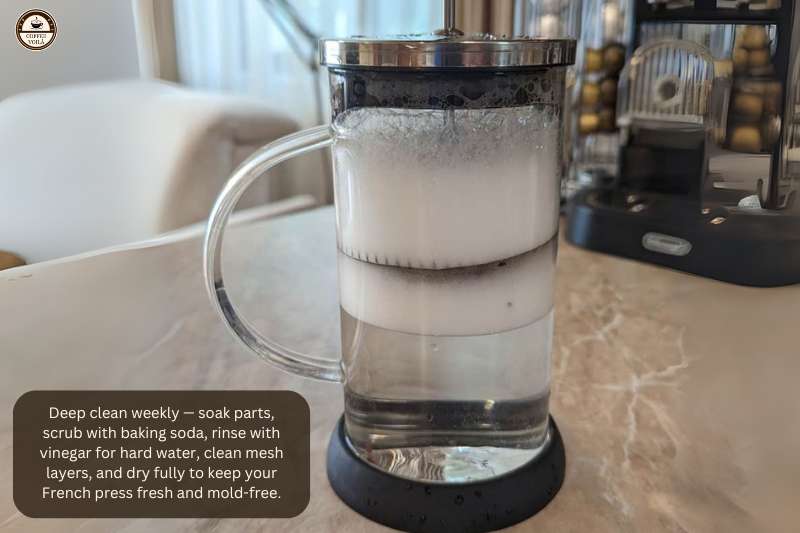
Soak Plunger, Mesh Filter, and Lid in Warm Soapy Water
Start by taking the press completely apart, your plunger, mesh filter, lid, the whole works. Then, drop everything (except the glass carafe) into a bowl of warm, soapy water and let it soak for 10–15 minutes. This softens old coffee oils and loosens grounds stuck in the mesh.
Use Baking Soda Paste for Stubborn Stains or Odors
If your carafe smells funky, or if you notice that brownish ring creeping up the glass or stainless, baking soda is your best friend.
For this, make a paste with a little water and scrub gently with a sponge. It’s gritty enough to lift stains but gentle enough not to scratch.
Bonus: it also removes any lingering odors that soap doesn’t.
Vinegar Rinse for Descaling Hard Water Buildup
If you live in a hard water area, minerals sneak in just like oils do. Over time, they leave a cloudy film that no amount of scrubbing removes.
That’s where vinegar comes in. You want to mix equal parts white vinegar and warm water, fill the carafe, and let it sit for 10 minutes.
Afterward, rinse thoroughly (unless you want your next brew tasting like salad dressing). Do this once a month and your press will stay crystal clear.
Clean Between Mesh Layers if Press Has Multiple Screens
Some French presses come with two or even three mesh screens stacked together for extra filtration.
Great for reducing sludge but terrible for trapping grounds. If you never separate them, residue piles up fast.
Unscrew the layers and clean each one individually. The first time I did this, I found a week’s worth of old grounds hiding there, and suddenly it made sense why my coffee had tasted bitter.
Thoroughly Dry Before Reassembling
This last step sounds boring, but it’s what keeps mold away. You should spread the pieces on a towel or dish rack and let them dry completely.
If you rush and reassemble while the parts are still damp, you’re essentially creating a little greenhouse for mildew.
How Often Should You Clean Your French Press?
The good news is you don’t need a complicated schedule; simply follow a routine that balances daily upkeep with deeper maintenance.
| Frequency | What to Do | Why It Matters |
|---|---|---|
| After every brew | Quick clean: scoop grounds, rinse with warm water, wash with a drop of soap, and let it dry | Prevents oils from turning rancid and keeps grounds from clumping to the bottom like cement |
| Weekly | Deep clean: take apart plunger, lid, and mesh; soak in warm soapy water; scrub filters individually | Stops hidden residue from building up under the mesh and extends the life of your press |
| Monthly | Vinegar rinse: fill carafe with a 1:1 mix of vinegar and warm water, let sit 10 minutes, rinse thoroughly | Removes mineral buildup from hard water that can leave your press cloudy and dull the taste of your coffee |
Last Thoughts
How do you usually deal with coffee grounds, trash, compost, or garden? Have you ever noticed your coffee tasting “off” because you skipped a clean? And do you think daily quick rinses are enough, or do you prefer a full scrub more often?
I recommend experimenting, finding the routine that works for you and with that… voilà.

